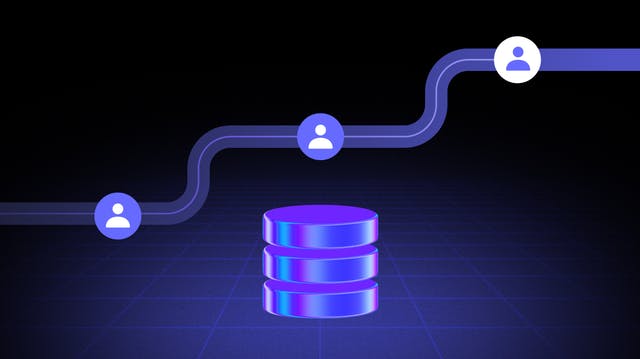4 ways to improve personalization programs with insights from the data warehouse
Data from your data warehouse may help make your personalization programs more targeted, relevant, and impactful–if you can leverage it effectively, that is. This blog post explores how leading brands are using data in the data warehouse to engage with customers in the moments that matter.

Cloud data warehouses have become an undeniable fixture of the modern data landscape. Storing vast quantities of diverse data, data warehouses make it easy for data teams to analyze historical trends, perform sophisticated analysis, and create visualizations that would be difficult to produce without a centralized system of record.
The data warehouse can also be an invaluable data resource for marketing teams, although realizing this value often requires overcoming a few hurdles—in most organizations, marketers require support from the data team to access, model, and query data in the data warehouse and build custom pipelines to downstream tools.
Marketers need to move fast, and this ‘barrier to entry’ often leads them to gravitate away from leveraging the data in the data warehouse. Instead, they rely primarily on their own set of customer data available in downstream customer analytics and engagement tools. This disconnect can create a perilous ‘data-divide’ within the organization:
- The data team invest in developing data products, analysis, and insights that aren’t directly influenced by Marketing’s needs
- Marketing doesn’t leverage proprietary insights developed by the data team in the data warehouse, hindering their ability to deliver differentiated customer experiences
When the insights in the data warehouse become easily actionable for marketing teams, however, Marketing has the opportunity to align more closely with the data team and deliver more impactful personalization campaigns.
This is the core challenge that mParticle Warehouse Sync was built to address. Warehouse Sync makes it possible for brands with warehouse-centric architectures to activate data in the data warehouse while also configuring the mParticle platform to meet their unique needs. Teams can ingest customer data from the data warehouse into mParticle to create an accessible 360-degree customer view and power personalization, or alternatively can connect data from the data warehouse directly to downstream tools without creating a duplicate data store. And with mParticle Value-based Pricing, teams can ensure costs align with the value they receive.
We’ve had the chance to speak to several leading brands about how they’re leveraging customer data from the data warehouse to engage users more strategically. Here are a few ways in which they’re pushing the boundaries of the customer experience–and you can too.
Giving the customer experience a makeover
A high-end retailer was storing a rich customer data set, including demographic information, purchase histories, and website and app interactions, product affinities and buying patterns in their data warehouse.
The marketing team at this brand was engaging their customers using marketing automation, social advertising, and email tools, but as these tools were not connected to the data warehouse, Marketing was left with a fragmented view of their customers and limited ability to drive impactful personalization. Building individual data connections between these downstream destinations was not an option––the time and effort required to do so would have caused the marketing team to miss valuable opportunities and distracted data engineers from core product initiatives.
mParticle’s Warehouse Sync makes it possible for the brand to connect their data warehouse with their customer engagement tools without ongoing engineering support. Using mParticle’s pre-built integrations with all of the brand’s marketing tools, the marketing team can streamline the process of activating customer data in their data warehouse. The real-time data connection enabled them to deliver timely and relevant messaging to customers. Connecting insights from the data warehouse, such as individual product interests and purchase history, to downstream tools via mParticle, the team is able to send personalized recommendations to each of their customers.
Pump up digital personalization with real-time engagement data
A cross-channel fitness brand wanted to leverage in-person member interactions to improve the digital experience. Whenever members check in to a club, purchase something at an in-club retail store, or schedule a value-add service like personal training, engagements are captured and stored in the data warehouse. This data can then be combined with data the brand is capturing in their digital experiences for members to create a 360 degree view of the member and offer members an even more personalized experience. Data science and BI teams also use this data to generate insights like historical check-in frequency, churn risk, and product affinity.
By connecting these insights to mParticle using Warehouse Sync, marketers can use them to tailor offers to specific individuals and customer segments that are most likely to convert. For example, they can offer personal training discounts to members who work out four times a week, and not to members who have yet to take advantage of their impulsive New Year’s resolution membership sign-up.
Energize one-to-one messaging with data warehouse insights
Now let’s consider the case of a specialty coffee brand looking for ways to inject some focus into their digital personalization campaigns. In addition to hundreds of restaurants, this brand also has brick-and-mortar retail stores where customers can purchase coffee beans and accessories. The brand also has mobile apps that customers can use to locate shops, place orders, and activate loyalty offers, as well as an ecommerce store where shoppers can purchase all of the same items they can find at physical locations.
All purchase and interaction data collected at shops and retail stores is sent to the brand’s data warehouse, and it’s here that their Data Science team uses this information to generate a host of predictive insights about their customers.
By connecting their data warehouse to mParticle using Warehouse Sync, all of the predictive insights the data science team has worked so hard to create can be linked to customer profiles easily accessible by business teams. Now, non-technical stakeholders are equipped with the insights they need to deliver more strategic customer experiences.
Using predictive insights based on customers’ past in-store orders, the product team is able to deliver recommendations within the mobile app that suggests relevant coffee flavors. With access to purchase history records, Marketing can now automate reorder reminder emails that prompt customers to get more beans when they’re likely running low.
Special delivery from the data warehouse
Last but not least, let’s discuss the personalization journey of a food delivery service that has aggregated valuable customer data from digital channels in their data warehouse. This brand is particularly interested in the types of meals their customers like, so their data warehouse stores a rich set of information on things like dietary preferences, meal ratings, and purchase history. The company’s Data Science team uses this information to tease out predictions and calculations such as average order value, taste preferences, and churn risk.
Using Warehouse Sync, they can connect these insights to Marketing’s engagement tools without data engineering support. Armed with this treasure trove of predictive information, the marketing team can serve a smorgasbord of personalized experiences to their customers.
For example, by analyzing dietary preferences, data scientists can generate personalized meal recommendations that incorporate seasonal ingredients. Connecting these recommendations into their CRM, Marketing can design seasonal campaigns that offer customers the best meal options for their interests.
Additionally, by analyzing engagement metrics and satisfaction indicators, the data science team can predict customers who are at risk of churning. When the marketing team has access to churn propensity data, they can proactively engage at-risk customers with personalized offers and other incentives that prevent churn.
Don’t let the personalization potential go untapped
Customer data stored in the data warehouses presents an enormous opportunity for marketing teams looking to take their campaign personalization to the next level. When historical data, insights, and predictions are available in the data warehouse, letting this information remain isolated from the systems that marketers use to drive personalization is a lost opportunity.
Until recently making this high-value information available to business teams required significant investment from the data team. With mParticle’s Warehouse Sync, any organization can now connect data warehouse insights to the systems Marketing uses to engage with their customers every day, accelerating time to data value while also increasing efficiency across the organization. Learn more about how to get started here.



